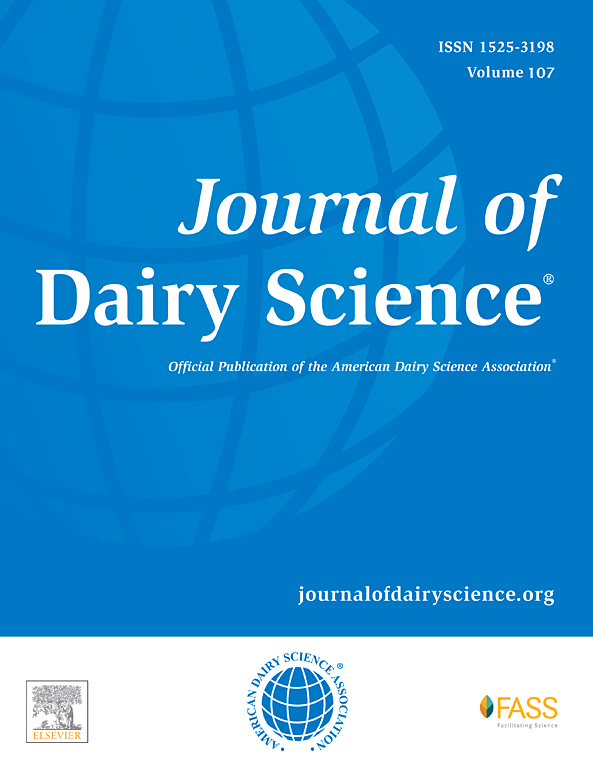通过牛牦牛基因组结构变异和转录组分析鉴定与杂交不育有关的候选基因
IF 4.4
1区 农林科学
Q1 AGRICULTURE, DAIRY & ANIMAL SCIENCE
引用次数: 0
摘要
亲缘关系密切但基因不相容的物种之间的杂交种往往不能存活或不育。牛-牦牛是牦牛和牛的种间杂交种,表现出雄性特有的不育性,这限制了其理想性状的固定,阻碍了通过杂交改良牦牛的基因。牛、牦牛和牛-牦牛睾丸组织的转录组图谱已经生成;然而,与杂交不育相关的基因表达差异所隐含的遗传变异尚未阐明。我们检测了 3 月龄、10 月龄和成年期牦牛和牛牦牛睾丸细胞组成和基因表达的差异。组织学分析表明,3月龄时最先进的生殖细胞是性腺细胞(前精原细胞),10月龄时是精母细胞。成年牦牛的曲细精管中发生了完全的精子发生,而在成年牛牦牛的睾丸中只检测到精原细胞和数量有限的精母细胞。转录组分析显示,牦牛和牛牦牛在每个阶段分别有180、6310和6112个差异表达基因(DEGs)。接着,我们检测了回交一代(BC1)的生精细胞类型,发现出现了圆形精子,表明这些动物的生精功能部分恢复。与牛-雅克相比,在 BC1 动物的睾丸中发现了 272 个 DEGs。值得注意的是,我们发现与牦牛相比,牛-牦牛睾丸中X染色体连锁基因的表达上调,这表明杂交动物的减数分裂性染色体失活(MSCI)过程可能存在异常。接下来,我们筛选了携带结构变异(SV)的DEGs,发现了一系列与精原细胞发育、减数分裂重组和双链断裂(DSB)修复相关的SV基因。此外,我们还发现SV基因ESCO2(姐妹染色单体内聚N-乙酰转移酶2的建立)和BRDT(溴域睾丸相关)可能参与了牛牦牛精母细胞减数分裂的停滞。总之,我们的研究为确定导致杂交不育的结构变异位点提供了一个宝贵的数据库。本文章由计算机程序翻译,如有差异,请以英文原文为准。
Identification of candidate genes related to hybrid sterility by genomic structural variation and transcriptome analyses in cattle-yak
Hybrids between closely related but genetically incompatible species are often inviable or sterile. Cattle-yak, an interspecific hybrid of yak and cattle, exhibits male-specific sterility, which limits the fixation of its desired traits and prevents genetic improvement in yak through crossbreeding. Transcriptome profiles of testicular tissues have been generated in cattle, yak, and cattle-yak; however, the genetic variations underlying differential gene expression associated with hybrid sterility have yet to be elucidated. We detected differences in the cellular composition and gene expression of testes from yak and cattle-yak at 3 mo of age, 10 mo of age, and adulthood. Histological analysis revealed that the most advanced germ cells were gonocytes (prospermatogonia) at 3 mo and spermatocytes at 10 mo. Complete spermatogenesis occurred in the seminiferous tubules of adult yak, whereas only spermatogonia and a limited number of spermatocytes were detected in the testis of adult cattle-yak. Transcriptome analysis revealed 180, 6,310, and 6,112 differentially expressed genes (DEG) in yak and cattle-yak at each stage, respectively. Next, we examined the spermatogenic cell types in the backcross generation (BC1) and detected the appearance of round spermatids, indicating the partial recovery of spermatogenesis in these animals. Compared with those in cattle-yak, 272 DEG were identified in the testes of BC1 animals. Notably, we discovered that the expression of X chromosome–linked genes was upregulated in the testis of cattle-yak compared with yak, suggesting a possible abnormality in the process of meiotic sex chromosome inactivation in hybrid animals. We next screened DEG harboring structural variations (SV) and identified a list of SV genes associated with spermatogonial development, meiotic recombination, and double-strand break repair. Furthermore, we found that the SV genes ESCO2 (establishment of sister chromatid cohesion N-acetyltransferase 2) and BRDT (bromodomain testis associated) may be involved in meiotic arrest of cattle-yak spermatocytes. Overall, our research provides a valuable database for identifying structural variant loci that contribute to hybrid sterility.
求助全文
通过发布文献求助,成功后即可免费获取论文全文。
去求助
来源期刊

Journal of Dairy Science
农林科学-奶制品与动物科学
CiteScore
7.90
自引率
17.10%
发文量
784
审稿时长
4.2 months
期刊介绍:
The official journal of the American Dairy Science Association®, Journal of Dairy Science® (JDS) is the leading peer-reviewed general dairy research journal in the world. JDS readers represent education, industry, and government agencies in more than 70 countries with interests in biochemistry, breeding, economics, engineering, environment, food science, genetics, microbiology, nutrition, pathology, physiology, processing, public health, quality assurance, and sanitation.
 求助内容:
求助内容: 应助结果提醒方式:
应助结果提醒方式:


